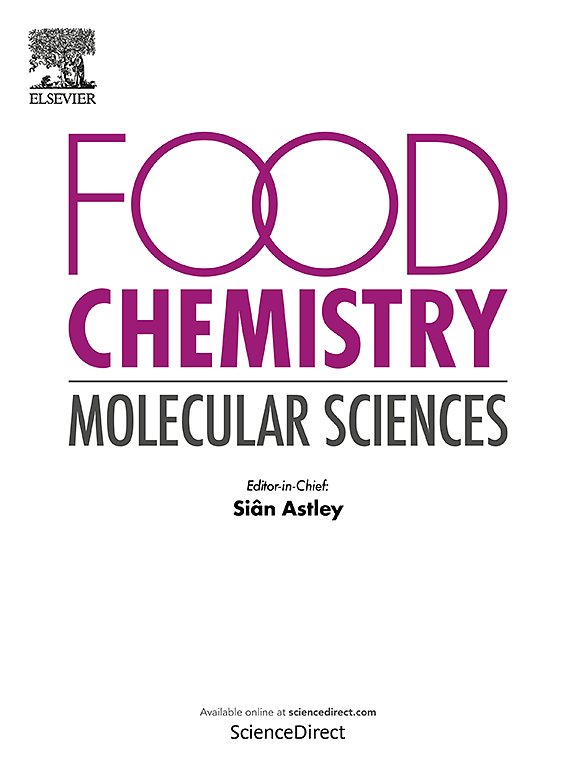Integrative transcriptomic and metabolomic analysis reveals the flavor formation mechanism of green bamboo (Dendrocalamopsis oldhami) shoots
IF 4.1
Q2 FOOD SCIENCE & TECHNOLOGY
引用次数: 0
Abstract
Green bamboo (Dendrocalamopsis oldhami) represents a crucial Asian grass with medical and edible value. However, the unpalatable flavor of emerging D. oldhami bamboo shoots has reduced consumer preference. The distinct flavor of bamboo shoots could potentially be attributed to the accumulation of differential metabolites linked to variations in bamboo shoots maturation, leading to a characteristic taste. In this study, to explore the molecular mechanisms underlying the formation of the flavor characteristics in bamboo shoots, we performed a joint transcriptomic and metabolomic analysis on the principal flavor components of D. oldhami (L) and D. oldhami ‘Hualvzhu’ (HL) bamboo shoots harvested at two developmental stages, unemerged and after emerging from the soil. Physiological analysis showed that HL presented a higher water content, lower lignin content, lower flavonoids content, a lower bitterness scoring value, and a higher sucrose content compared to L. LC-MS/MS analysis identified 23,064 primary-level differential metabolites from four comparison groups, and the differential accumulation patterns of ascorbic acid and sucrose were found to cause flavor differences. GO and KEGG enrichment analysis of the transcriptomic data demonstrated that ‘Biosynthesis of secondary metabolites’ and ‘Starch and sucrose metabolism’ were the major enrichment pathways. The expression levels of GLDH, L-galDH1, and GME1 were positively correlated with ascorbic acid accumulation, whereas those of SPS1, SPP1, and SPP2 were positively correlated with sucrose accumulation. Additionally, transcription factors like AP2/ERF, NAC, and GRAS were potentially involved in the biosynthesis of ascorbic acid and sucrose. Overall, our findings firstly uncovered the flavor formation mechanism of D. oldhami bamboo shoots, offering a theoretical basis for industrial growth.
综合转录组学和代谢组学分析揭示了青竹(Dendrocalamopsis oldhami)芽味形成机制
青竹(Dendrocalamopsis oldhami)是一种重要的亚洲草,具有药用和食用价值。然而,新兴竹笋的难吃味道降低了消费者的偏好。竹笋的独特风味可能归因于与竹笋成熟变化相关的差异代谢物的积累,从而产生独特的味道。为了探索竹笋风味特征形成的分子机制,本研究对未出苗和出土后两个发育阶段收获的D. oldhami (L)和D. oldhami ' Hualvzhu ' (HL)竹笋的主要风味成分进行了转录组学和代谢组学分析。生理分析表明,与l相比,HL具有更高的水分含量、更低的木质素含量、更低的黄酮类化合物含量、更低的苦味评分值和更高的蔗糖含量。LC-MS/MS分析鉴定出4个对照组的23,064种初级差异代谢物,发现抗坏血酸和蔗糖的不同积累模式导致了风味差异。转录组学数据的GO和KEGG富集分析表明,“次生代谢物的生物合成”和“淀粉和蔗糖代谢”是主要的富集途径。GLDH、L-galDH1和GME1的表达水平与抗坏血酸积累呈正相关,SPS1、SPP1和SPP2的表达水平与蔗糖积累呈正相关。此外,AP2/ERF、NAC和GRAS等转录因子可能参与抗坏血酸和蔗糖的生物合成。总体而言,我们的研究结果首次揭示了竹笋风味的形成机制,为竹笋产业发展提供了理论依据。
本文章由计算机程序翻译,如有差异,请以英文原文为准。
求助全文
约1分钟内获得全文
求助全文
来源期刊

Food Chemistry Molecular Sciences
Agricultural and Biological Sciences-Food Science
CiteScore
6.00
自引率
0.00%
发文量
83
审稿时长
82 days
期刊介绍:
Food Chemistry: Molecular Sciences is one of three companion journals to the highly respected Food Chemistry.
Food Chemistry: Molecular Sciences is an open access journal publishing research advancing the theory and practice of molecular sciences of foods.
The types of articles considered are original research articles, analytical methods, comprehensive reviews and commentaries.
Topics include:
Molecular sciences relating to major and minor components of food (nutrients and bioactives) and their physiological, sensory, flavour, and microbiological aspects; data must be sufficient to demonstrate relevance to foods and as consumed by humans
Changes in molecular composition or structure in foods occurring or induced during growth, distribution and processing (industrial or domestic) or as a result of human metabolism
Quality, safety, authenticity and traceability of foods and packaging materials
Valorisation of food waste arising from processing and exploitation of by-products
Molecular sciences of additives, contaminants including agro-chemicals, together with their metabolism, food fate and benefit: risk to human health
Novel analytical and computational (bioinformatics) methods related to foods as consumed, nutrients and bioactives, sensory, metabolic fate, and origins of foods. Articles must be concerned with new or novel methods or novel uses and must be applied to real-world samples to demonstrate robustness. Those dealing with significant improvements to existing methods or foods and commodities from different regions, and re-use of existing data will be considered, provided authors can establish sufficient originality.
 求助内容:
求助内容: 应助结果提醒方式:
应助结果提醒方式:


